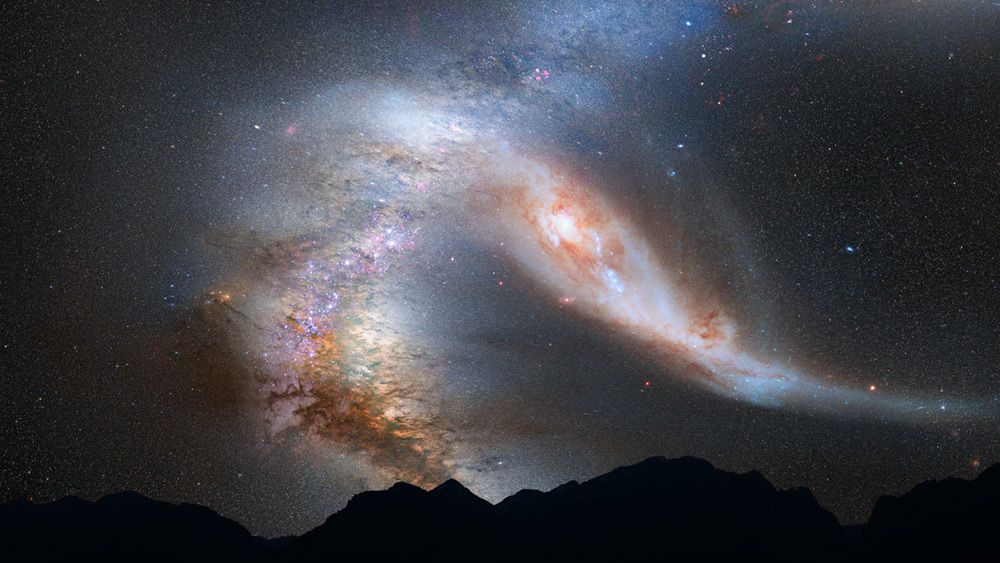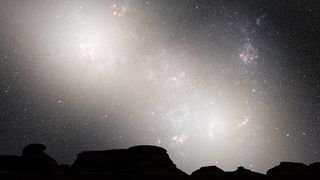
Four billion years from now, the Milky Way galaxy as we know it will cease to exist.
Our Milky Way is bound for a head-on collision with the similar-sized Andromeda galaxy, researchers announced today (May 31). Over time, the huge galactic smashup will create an entirely new hybrid galaxy, one likely bearing an elliptical shape rather than the Milky Way's trademark spiral-armed disk.
"We do know of other galaxies in the local universe around us that are in the process of colliding and merging," Roeland van der Marel, of the Space Telescope Science Institute in Baltimore, told reporters today. "However, what makes the future merger of the Andromeda galaxy and the Milky Way so special is that it will happen to us."
Astronomers have long known that the Milky Way and Andromeda, which is also known as M31, are barrelling toward one another at a speed of about 250,000 mph (400,000 kph). They have also long suspected that the two galaxies may slam into each other billions of years down the road. [Milky Way Slams Into Andromeda (Artist Images)]
However, such discussions of the future galactic crash have always remained somewhat speculative, because no one had managed to measure Andromeda's sideways motion — a key component of that galaxy's path through space.
But that's no longer the case.
Van der Marel and his colleagues used NASA's Hubble space telescope to repeatedly observe select regions of Andromeda over a seven-year period. They were able to measure the galaxy's sideways (or tangential) motion, and they found that Andromeda and the Milky Way are indeed bound for a direct hit.
Sign up for the Live Science daily newsletter now
Get the world’s most fascinating discoveries delivered straight to your inbox.
"The Andromeda galaxy is heading straight in our direction," van der Marel said. "The galaxies will collide, and they will merge together to form one new galaxy." He and his colleagues also created a video simulation of the Milky Way crash into Andromeda.
That merger, van der Marel added, begins in 4 billion years and will be complete by about 6 billion years from now.
A future cosmic crash
Such a dramatic event has never occurred in the long history of our Milky Way, which likely began taking shape about 13.5 billion years ago.
"The Milky Way has had, probably, quite a lot of small, minor mergers," said Rosemary Wyse of Johns Hopkins University in Baltimore, who was not affiliated with the new study. "But this major merger will be unprecedented."
The merger poses no real danger of destroying Earth or our solar system, researchers said. The stretches of empty space separating the stars in the two galaxies will remain vast, making any collisions or serious perturbations unlikely.
However, our solar system will likely get booted out to a different position in the new galaxy, which some astronomers have dubbed the "Milkomeda galaxy." Simulations show that we'll probably occupy a spot much farther from the galactic core than we do today, researchers said.

A new night sky
And the collision will change our night sky dramatically. If any humans are still around 3.75 billion years from now, they'll see Andromeda fill their field of view as it sidles up next to our own Milky Way. For the next few billion years after that, stargazers will be spellbound by the merger, which will trigger intense bouts of star formation.
Finally, by about 7 billion years from now, the bright core of the elliptical Milkomeda galaxy will dominate the night sky, researchers said. (The odds of viewing this sight, at least from Earth, are pretty slim, since the sun is predicted to bloat into a huge red giant 5 or 6 billion years from now.)
In its 22-year history, Hubble has revolutionized the way humanity views the cosmos. The new finding is another step in that process, researchers said.
"What's really exciting about the current measurements is, it's not about historical astronomy; it's not about looking back in time, understanding the expansion of the universe," said John Grunsfeld, associate administrator for NASA's Science Mission Directorate and a former astronaut who flew on three space shuttle missions that repaired Hubble .
"It's looking forward in time, which is another very human story," Grunsfeld added. "We like to know about our past — where did we come from? We very much like to know where we're going."
This story was provided by SPACE.com, a sister site to LiveScience. You can follow SPACE.com senior writer Mike Wall on Twitter: @michaeldwall. Follow SPACE.com for the latest in space science and exploration news on Twitter @Spacedotcom and on Facebook.













